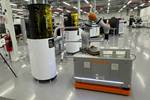5 Ways Collaborative Robots and 3D Printing Go Together
Collaborative robots (cobots) are seemingly everywhere — a defining automation technology today. And cobots have a relationship with additive manufacturing that is, well, collaborative. While cobots need custom hardware AM can provide, they are well suited to aid AM production. Here is just some of what we have seen of the interaction between cobots and 3D printing.
-
3D printing offers a natural way to make the cobot’s end effectors.

A 3D printed bracket secures the optical measurement unit on this vision-guided cobot at Thyssenkrupp Bilstein, a company with extensive in-house 3D printing to support collaborative automation. This bracket was made from nylon via Multi Jet Fusion after an ABS bracket proved to be too flexible.
- 3D printing makes other cobot hardware, too. The need is great enough that it takes in-house AM to support a large-scale cobot commitment.
- For AM, on the other hand, a cobot can assure continuous production by loading and unloading 3D printers.
- An autonomous mobile cobot can even load and unload the 3D printer and carry parts away.
- The cobot itself can even be the 3D printer. (And this bonus: It can also film the 3D printing. A cobot carrying the camera for time-lapse footage allows for sweeping viewpoint changes.)
Related Content
-
UltiMaker Targets Light Industrial Applications With 3D Printer Designed for the Factory Floor
The company’s Factor 4 3D printer introduced this week is designed to complement conventional manufacturing equipment including CNC machining and automation.
-
Combining Metal and Polymer for Better 3D Printed Tools
Applications prone to wear call for more durable tooling than 3D printed polymer alone, but full metal is not always necessary.
-
Chuck Jaws Achieve 77% Weight Reduction Through 3D Printing
Alpha Precision Group (APG) has developed an innovative workholding design for faster spindle speeds through sinter-based additive manufacturing.











